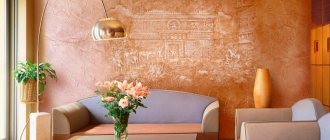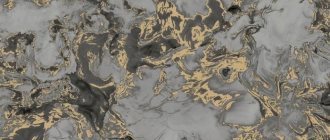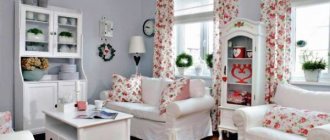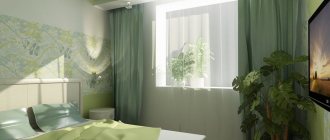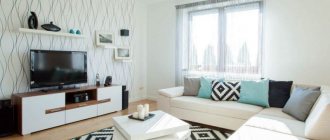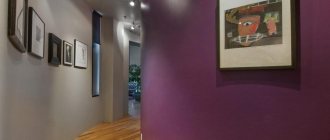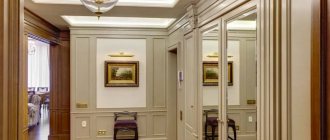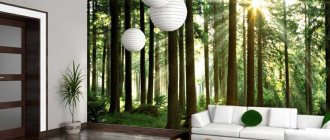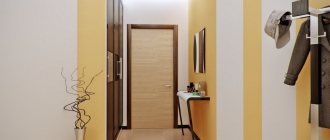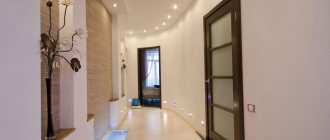As you know, the theater begins with a dressing room. So our apartment begins with the hallway. All people who come to the house first of all end up here. Very often, the first impression of the owner and his home is based on its appearance. Therefore, renovating a hallway is no small matter, and sometimes it requires special attention.
The hallway is the first place where a person enters, so it should look decent and set the tone for the entire apartment.
Features of liquid wallpaper
The composition of liquid wallpaper may include cotton and cellulose fibers, dyes, glitters and glue, which quickly soaks and adheres well to the surface. Liquid wallpaper is sold in the form of powder or granules.
The principle of working with the material is similar to using plaster. Granules or powder are diluted with water, mixed well and applied to the wall. Thanks to the unique texture of the wallpaper, it can even be applied to a wall with bumps, holes, chips and other defects without prior preparation of such a surface.
Combination of liquid wallpaper with wood in hallway design Source luxury-house.org
Liquid wallpaper in the hallway photo of interiors
The popularity of liquid wallpaper, growing since its invention, is based not only on the novelty of the material, but also on the decorative capabilities of silk plaster (a popular name that reflects one of the resulting effects). Choosing a material with an unusual texture for the hallway will make a small room original and unique. Fortunately, you can find mixtures of the desired color, come up with a design and realize any fantasy with your own hands.
Ideas for using liquid wallpaper for a corridor can be gleaned by looking at photos, trying on ready-made solutions for your room, or coming up with your own “highlights”.
Advantages and disadvantages of the material
The demand for liquid wallpaper in the corridor can be easily explained by its advantages:
- Before applying them to the wall, its surface does not need to be specially prepared.
- Possibility of use not only for walls or ceilings, but also for other surfaces. For example, pipes, radiators, etc.
- High rates of heat and sound insulation. This coating is breathable due to its special texture.
- No joints or seams. The entire surface is a monolithic canvas.
- Simplicity of finishing walls in the hallway with liquid wallpaper. Any person can cope with such work, including those without special skills. Even if the applied layer is not completely even, thanks to the special texture, it will not be noticeable.
- The presence of an antistatic effect, which prevents dust from settling on the surface.
- Easy to maintain and able to be restored if damaged. Therefore, liquid wallpaper will be an ideal option for those who have small children or pets in their home. If the area is dirty or damaged, it is carefully cut out and a new layer of liquid wallpaper is applied in its place.
- The material does not absorb foreign odors and does not fade even when exposed to sunlight. Even after years, its appearance does not change, does not brighten or fade.
- Large selection of shades and textures and affordable material costs.
- Material safety. When exposed to high temperatures, liquid wallpaper does not emit toxic substances hazardous to humans.
- Possibility of applying a design to its surface. Moreover, after a while, the pattern can be removed without harm to surrounding surfaces and a new one can be applied. This will allow you to constantly update the appearance of the hallway without significant material and labor costs.
Two-color liquid wallpaper in the hallway Source j.etagi.com
There are not many disadvantages of this finishing material, but you still need to remember them:
- not suitable for rooms with high humidity levels;
- liquid wallpaper needs at least 3 days to dry completely;
- To increase service life, it requires additional treatment (coating with acrylic varnish or primer).
Beige liquid wallpaper in the hallway Source j.etagi.com
Popular colors and patterns
These finishing materials are presented by manufacturers in various shades. Using beige will help highlight furniture elements, give comfort and softness.
The types of liquid wallpaper depend mainly on the substances used in the composition.
For lovers of creativity, combinations of different shades and additional elements in the form of rhinestones or sparkles, and the use of silk are suitable. This kind of symbiosis will visually increase the space of the hallway and add individuality.
Note! It is better to use light shades for the corridor. Dark colors will add gloominess and visually make the room even smaller, especially if you don’t think through a special lighting system.
The ideal solution when choosing colors in the hallway would be peach tones, golden, beige, as well as light shades of gray.
When choosing liquid wallpaper, you should take into account the lighting in the room: if the room is well lit, then any colors will do.
A double corridor can be decorated with the same wallpaper or harmoniously combined options of different colors.
Liquid wallpaper allows you to use several colors simultaneously with a pattern in one room, or vice versa - one tone without a pattern and with it.
Types of liquid wallpaper
Based on the raw materials used for production, liquid wallpaper in the hallway is divided into types:
- Cellulose. This is the simplest liquid wallpaper based on paper. They are too susceptible to high humidity, so they are not suitable for all rooms. And due to the fact that it is impossible to wash them, the service life of this type of material is minimal.
- Silk. In addition to paper, this material is also based on silk fibers. Their service life is longer than that of cellulose wallpaper, but they are also sensitive to various mechanical influences.
- With stone chips. This type of wallpaper is the most durable and resistant to damage. This was achieved through the use of a special textured stone material. This option can be considered ideal for applications in the corridor. The only drawback of such wallpapers is their price.
- Combined wallpaper. They are granules that turn white when mixed with glue. This option is suitable for those who want to create their own wall shade. To do this, just add a suitable color to the source material.
Hallway design with liquid wallpaper Source repaireasily.ru
What does the market offer?
The market for finishing materials is developing rapidly, and if a few decades ago the consumer was extremely limited in his choice, today he has to show some patience before the final choice is made.
So, what does a buyer usually encounter when choosing wall materials for a bedroom?
- Vinyl, paper and non-woven wallpaper - there are many varieties of these coverings, and the simplest and safest from an environmental point of view are paper ones. But their main disadvantage is their fragility. And in the process of gluing, you should not hesitate, since under the influence of glue, the canvas can quickly lose its shape. Non-woven and vinyl wallpapers are more modern. They do not fade under sunlight, have an easier gluing process, and are durable. But you cannot always be sure of the absolute environmental friendliness of these fabrics, since any violation of the production technology becomes the main reason for the release of toxic elements.
- Natural, eco-wallpaper - appeared relatively recently, is absolutely environmentally friendly, but has a high cost.
- Decorative plaster – while wallpapering does not require any special skills, working with decorative plaster requires not only tools, but also theoretical knowledge and practical experience. First, the material is applied to the surface and then structured with special tools.
- Liquid wallpaper is an ideal modern wall covering that is perfect for decorating the interior of a hallway. Even a beginner can handle decorating hallway walls with this material. In addition, they are absolutely harmless to human health.
All finishing work can be done by hand
Selecting a shade
When choosing the color of liquid wallpaper, you should pay attention to the lighting in the corridor and the interior design of the room:
- In a small corridor with insufficient lighting, it is better to use wallpaper in light shades. A combination of white and yellow shades will look good.
- To focus attention on the furniture, it is better to make the walls a shade of ivory or cream.
- Blue and blue tones will make the interior of the corridor more fresh.
- Red and gray colors are called helpers. They are recommended to be used in cases where the layout leaves much to be desired, and it is impossible to correct it in other ways.
- In a corridor with high walls and light-colored furniture, walls in brown shades will look good.
- The black and white color scheme will go well with metal surfaces. Therefore, it is often chosen when decorating a corridor in modern styles (high-tech, minimalism, etc.).
Recommendations before repair
Here are some useful tips when mixing liquid wallpaper:
- Take exactly as much water as prescribed in the instructions for the mixture;
- The powder is poured into the water, and not vice versa;
- Follow the rule: one container - one package;
- The liquid coating must be mixed manually; using a drill will disrupt the structure of the fibers;
- The finished mixture can be stored for 2-3 weeks if unopened.
Always mix just the right amount for all walls. If there are liquid wallpapers of different mixtures on the surface, this will be visible by the different tone. The amount of material should be calculated based on the following parameters: 1 kg of mixture per 6 m2. If after painting one wall there is a little mixture left, it can be poured into a new solution.
Application process
To apply the mixture to the wall surface you will need:
- Grater;
- Putty knife;
- Spray.
The process of applying liquid wallpaper is carried out as follows:
Place a small amount of solution on a spatula; Apply the mixture to the wall, then rub it with a float until the coating thickness is 3 mm; It is important not to lift the tool from the wall while rubbing, otherwise unsightly seams will remain; While controlling the pressure on the float, continue applying the coating to the wall; The filled area must be leveled so that there are no lumps left; to do this, just moisten the grater and treat the surface with it; Once the mixture is applied to the walls, moisten the spatula in water and run it over the surface again for final leveling.
Liquid wallpaper in the hallway takes 2 to 3 days to dry. To make the process go faster, the room must be well ventilated, so the moisture will evaporate more intensely.
The temperature in the corridor should not be lower than +10 degrees.
Creating a drawing
In the interior of the hallway, liquid wallpaper with a pattern looks great. How to apply your favorite ornament or design:
- Make markings with a pencil;
- Apply the finishing mixture strictly along the lines in the direction from the center to the edge;
- Wait for the drawing to dry (usually this takes about 24 hours);
- Adjust the picture using a rubber spatula, move excess material to the center, and trim unnecessary elements with a sharp knife;
- Before applying the main background, cover the drawing with masking tape.
Different colors and textures on the walls look more impressive than plain coatings, creating a wide variety of compositions on the walls. You can draw waves, stripes, floral patterns, flowers, animals, clouds, etc. in the corridor.
With proper application and care, the liquid coating of the walls in the corridor will last a long time. Such surfaces can be easily changed, refreshing the interior. The variety of shades and textures allows you to create anything, even full-fledged drawings on the walls of the corridor.
Combination with other materials
Liquid wallpaper in the hallway can be combined with other finishing materials:
- Non-woven, vinyl and other types of wallpaper. This is a classic option that will suit any hallway design. It is not recommended to use paper wallpaper due to its fragility.
- Wood, bamboo, stone and other natural materials. These materials are safe and durable, however, they cannot withstand fluctuations in temperature and humidity.
- Decorative plaster. In terms of strength and durability, this material is similar to liquid wallpaper. When choosing this combination, you need to ensure that their layers are of the same thickness.
Liquid wallpaper has a special texture, so it is not recommended to use a lot of decor in the hallway, otherwise the interior will turn out to be overloaded and the space will be compressed.
Drawing with liquid wallpaper in the hallway Source prihozhaya.guru
Designers offer the following options for combining materials in the corridor:
- Horizontal zoning. This way you can make the room visually lower, but more elongated in width. If the hallway has low ceilings, then this option should be excluded.
- Vertical separation. This method allows you to visually make the room taller. But you need to avoid vertical stripes in a narrow corridor.
- Separate inserts. In this case, liquid wallpaper is combined with others (non-woven, vinyl). They can be separated from each other by a frame or moldings.
What can you combine with?
- In the hallway you can combine liquid wallpaper with classic vinyl canvases.
- Using several colors in your work allows you to refresh the composition. A colorful and harmonious interior is achieved by creating clear boundaries.
- By drawing a horizontal strip along the entire wall, you can determine the boundaries of a particular pattern. There are no clear recommendations or restrictions in terms of combinations. Here fantasy comes first, setting the tone for the work and influencing the final result.
Selection rules
There is a large selection of liquid wallpaper on the market. To choose the best option, you need to follow these recommendations:
- The product must be practical and resistant to various external influences. At the same time, caring for them should be simple.
- Before purchasing, it is important to choose the right shade of the material. The perception of the hallway will depend on this.
- It is not recommended to save on buying wallpaper. The higher quality the material is, the longer it will last. In addition, in this case you can be confident in their quality and safety.
Combining liquid wallpaper on an arch in the hallway Source elit-decor.zp.ua
Finishing
It will take some time to prepare liquid wallpaper for application, so preparation should begin already at the stage of priming the walls, when the repair is coming to an end. A dry wallpaper mixture can be prepared from individual ingredients contained in different bags, or all components can be already mixed in one bag.
When diluting the dry mixture, you must take only the amount of water specified in the instructions.
The contents of the package must be mixed in full in a separate container. You need to pour the dry mixture into the water, and not vice versa. To homogenize the mass, the use of drills is not recommended; this process may entail a change in the structure of the fibers and, accordingly, a violation of the consistency.
To apply liquid wallpaper, the same tools can be used as for applying plaster. The number of portions required for application to a certain area should be done in one batch, since the compositions of different batches on the same wall may vary slightly. You can calculate the amount of the mixture based on the instructions for use. On average, 1 kg of wallpaper can be distributed over 5-6 square meters. m of surface. The remains from mixing on one wall can be used in mixing for another wall.
Using a spatula, the prepared material is grated and applied to the surface in small portions. The composition is ground to a thickness of 2-3 mm; it is advisable not to lift your hand from the surface being treated to avoid the formation of seams. By adjusting the pressure on the tool, the composition is applied in this way until an area of approximately 1 square meter is filled. m, after which the finished area is leveled with a grater dipped in water. After finishing the entire wall, you need to go over the surface with a wet grater again.
Mixtures of different colors are used to apply patterns. The sketch must be applied to the surface of the wall, and then the desired compositions should be applied in several stages with an interval of a day.
Application rules
Using liquid wallpaper to decorate a corridor is not a quick process. You only need to spend about 10-12 hours preparing the composition. The final result depends on how correctly the mixture is prepared. To do this, it is advised to adhere to certain rules:
- Before you start mixing ingredients, it is important to read the instructions. The volume of added water must strictly correspond to that specified by the manufacturer.
- First, water is poured into the mixing container. Then immediately pour out the entire volume of the dry mixture.
- It is best to mix the ingredients by hand. If you use a drill, the fibers of the material are damaged, which negatively affects the appearance of the coating. To produce the mixture, environmentally friendly materials are used, so it is absolutely safe and can be worked with by hand.
- It is advisable to correctly calculate the exact amount of material required for one batch. If there is not enough material, then there is a risk that after drying the shade of the mixture from different batches will be different. The mixture is sold in 1 kg bags. This amount is enough to cover 4-6 meters of a square wall.
Brown hallway with liquid wallpaper on the wall Source rehouz.info
Which liquid wallpaper is best to choose for the hallway
The finishing material consists of several components that serve:
- connecting (binders) substances;
- decorative details;
- structure-forming components (natural and also artificial fibers);
- functional additives.
On the shelves you can find both dry mixtures (packaged powders of 1-2 kg) and dough-like mass (in buckets).
The adhesive substances included in the composition are able to dissolve in water, forming a gel-like mass. These are busylate, polyvinyl acetate or CMC adhesives. When drying, the adhesives form a transparent film and do not emit harmful substances when diluted or when drying. The film is elastic, so it can withstand small shrinkages without cracking. They are capable of re-liquefying, which is why the compositions are not used for exterior finishing of houses.
Stylistic decision
Liquid wallpaper is suitable for decorating a hallway in any style:
- Classic. This style is characterized by muted tones (beige, white). If you want to decorate the walls with drawings, then they must be applied symmetrically. Depending on the size of the corridor, you can use a print with horizontal or vertical stripes.
- Modern style. Art Nouveau is characterized by graceful lines. A hallway in which one wall is covered with plain wallpaper and a large pattern on the opposite wall will look ideal. High-tech is characterized by the shine of glass or metal. Therefore, glossy surfaces are used for finishing, and wallpapers with metallic admixtures or those containing fiberglass are chosen.
- Provence. It is characterized by elegant and light colors with a floral pattern, checkered pattern or other small pattern. The main thing is that lavender and olive tones prevail in combination with mustard, blue, yellow, and brown.
- Scandinavian style involves the use of white and other cool tones. The walls can be plain or decorated with a dim pattern.
Drawing with liquid wallpaper on the wall in the corridor Source mykaleidoscope.ru
Liquid wallpaper in the hallway of different styles
We have already listed above the colors that are more suitable for various styles. Now about the hallway design styles used when finishing with silk plaster. For a classic hallway, liquid wallpaper is a godsend, adding a modern touch to the classics. Light colors harmoniously combine with dark furniture, seamless joints, golden sparkles - everything creates the effect of a palace. The effect increases with the placement of sconce lamps on opposite walls, thoughtful placement of paintings, and the use of moldings.
Method two
Here the process is somewhat simpler than in the first option, and the ornament can be obtained more gracefully and without flaws. To do this, you will need a stencil with the desired design; you can make it yourself, or order it from any advertising agency that has a plotter cutter.
First, a background is created, or the entire wall is covered with liquid wallpaper. After they have dried, a stencil is attached using masking tape and a new layer of wallpaper is applied on top of it in a different color than on the wall.
Important! After application, you need to wait about half an hour, and only then remove the stencil. During this time, the wallpaper layer will have time to dry, and drips will not form.
You can watch the video on how to work with a stencil.
Additional Tips
To make your photo wallpaper look as impressive as possible, use the following tips:
- Think about lighting. The drawing may get lost in a dark corner. On the contrary, lighting located in the right places can complement the overall impression of photo wallpaper;
- A mirror sheet on cabinet doors or on the wall will help increase the space, as well as the effect of the pattern on the wall;
- Usually photo wallpapers are self-sufficient. But sometimes additional decorative elements enhance the impression of the design. For example, next to a photo of a boulevard, a bench with a floor lamp in the shape of a street lamp would look appropriate;
- Bright, small-sized photo wallpapers can be framed to become an interior decoration.
Small photo wallpapers can be framed to become an interior decoration.
Many people want to make their hallway interesting and memorable. Photo wallpapers are an excellent option for them due to their effectiveness, ease of installation and accessibility.
